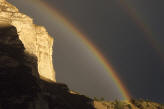 Just as geology
determines biology, biology also impacts the geology. From this vantage
point you can see how the type of rock that composes the different steps
of the Grand
Staircase determines what kinds of plants can grow on it. The varying
densities of vegetation determine how erosion shapes the land. Just as geology
determines biology, biology also impacts the geology. From this vantage
point you can see how the type of rock that composes the different steps
of the Grand
Staircase determines what kinds of plants can grow on it. The varying
densities of vegetation determine how erosion shapes the land.
In the slick rock sandstone of the White Cliffs the
soil is thin or nonexistent and plants cannot easily take hold. The lack
of plants causes this region to endure intense erosion with each rainstorm
forming deep canyons, rounded domes and pointed nipples.
Where the roots of trees and plants can get
established they help stabilize the soil and rock underneath. This is
evident in the Grey Cliffs, the sequence of rock that lies above the White
Cliffs. The Grey Cliffs are made of rock that consists f a combination of
sand, shale, and clay. This combination produces better soils allowing
dense vegetation, which better protects the rock underneath by absorbing
some of the rainfall and preventing flash floods.
Notice how canyons through the Grey Cliffs are
wider, meander more, and aren't as deep as those through the White Cliffs?
The difference is the presence or absence of flash flood erosion. Even
though the White Cliffs are composed of more durable rock than the Grey
Cliffs, they still erode at a faster rate! Just as geology influences
plants, plants control geology.
Nature
Ponderosa Canyon is so named because of the huge Ponderosa Pines on the
canyon floor. Some of these trees measure more than 5 ft. in diameter and
exceed heights of 150 ft. However from high above at the viewpoint you
would never know this. In fact many are confused by the name, not
expecting to find themselves surrounded by a forest of Blue Spruce and
Douglas-fir. Certain types of vegetation grow in certain environments
according to conditions such as moisture and temperature. These conditions
are strongly controlled by elevation. Forests, therefore, are divided into
zones or forest types according to elevation, because a forest's dominant
tree species varies with these changes in elevation.
Bryce Canyon National Park encompasses three of
these forest types from the lowest elevations below the rim of the canyon
to the upper elevations in the southernmost end of the park. At the bottom
is the Pinyon-Juniper Woodland Belt, dominated by the Pinyon Pine and the
Utah Juniper. The rim of the canyon in the northern end of the park is
dominated by the Ponderosa Pine, and is thus classified as a Ponderosa
Pine Forest. At the highest elevations, like here at Ponderosa Point, Blue
Spruce, Douglas-fir and White Fir are the most common tree species,
indicative of a Spruce-Fir Forest.
Trails
Agua Canyon Connecting Trail
Services
None
|

